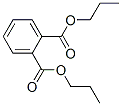-
Name
DIPROPYL PHTHALATE
- EINECS 205-015-8
- CAS No. 131-16-8
- Article Data13
- CAS DataBase
- Density 1.082 g/cm3
- Solubility 108.1mg/L(20 oC)
- Melting Point -31°C
- Formula C14H18O4
- Boiling Point 317.28 °C at 760 mmHg
- Molecular Weight 250.295
- Flash Point 166.289 °C
- Transport Information UN 3082 9/PG 3
- Appearance clear colorless liquid
- Safety 61
- Risk Codes 51/53
-
Molecular Structure
-
Hazard Symbols
 N
N
- Synonyms 1,2-Benzenedicarboxylicacid, dipropyl ester (9CI);Phthalic acid, dipropyl ester (6CI,7CI,8CI);Di-n-Propyl phthalate;Dipropyl benzene-1,2-dicarboxylate;NSC 15314;
- PSA 52.60000
- LogP 2.82020
DIPROPYL PHTHALATE Chemical Properties
IUPAC Name: Dipropyl benzene-1,2-dicarboxylate
The MF of Dipropyl phthalate (CAS NO.131-16-8) is C14H18O4.

The MW of Dipropyl phthalate (CAS NO.131-16-8) is 250.29.
Synonyms of Dipropyl phthalate (CAS NO.131-16-8): 1,2-Benzenedicarboxylic acid, dipropyl ester ; Dipropyl benzene-1,2-dicarboxylate ; Benzene-1,2-dicarboxylic acid di-n-propyl ester ; Di-n-propyl phthalate ; Dipropyl phthalate
Product Categories: Analytical Chemistry;Environmental Endocrine Disruptors;Functional Materials;Phthalates (Environmental Endocrine Disruptors)
Apperance: clear colorless liquid
Index of Refraction: 1.502
EINECS: 205-015-8
Density: 1.082 g/ml
Flash Point: 166.3 °C
Boiling Point: 317.3 °C
BRN: 2332522
DIPROPYL PHTHALATE Uses
Dipropyl phthalate (CAS NO.131-16-8) is used to make plasticizers and polymer additives.Also used in chemical reagents, organic intermediates.
DIPROPYL PHTHALATE Toxicity Data With Reference
| 1. | orl-mus TDLo:630 g/kg (male 15W pre): REP | FAATDF Fundamental and Applied Toxicology. 12 (1989),508. | ||
| 2. | orl-mus TDLo:1260 g/kg (male 15W pre): REP | FAATDF Fundamental and Applied Toxicology. 12 (1989),508. | ||
| 3. | orl-mus TDLo:1260 g/kg (male 15W pre): REP | FAATDF Fundamental and Applied Toxicology. 12 (1989),508. | ||
| 4. | ipr-mus LDLo:1251 mg/kg | JPMSAE Journal of Pharmaceutical Sciences. 56 (1967),1446. |
DIPROPYL PHTHALATE Consensus Reports
Reported in EPA TSCA Inventory.
DIPROPYL PHTHALATE Safety Profile
Moderately toxic by intraperitoneal route. Experimental reproductive effects. An irritant. Combustible when exposed to heat and flame. When heated to decomposition it emits acrid smoke and irritating fumes.Safety information of Dipropyl phthalate (CAS NO.131-16-8):
Hazard Codes  N
N
Risk Statements
51/53 Toxic to aquatic organisms, may cause long-term adverse effects in the aquatic environment
Safety Statements
61 Avoid release to the environment. Refer to special instructions safety data sheet
RIDADR UN 3082 9/PG 3
WGK Germany 3
RTECS TI1940000
DIPROPYL PHTHALATE Specification
It is an ester. Esters react with acids to liberate heat along with alcohols and acids. Strong oxidizing acids may cause a vigorous reaction that is sufficiently exothermic to ignite the reaction products. Heat is also generated by the interaction of esters with caustic solutions. Flammable hydrogen is generated by mixing esters with alkali metals and hydrides.
Related Products
- Dipropyl adipate
- Dipropyl carbonate
- Dipropyl chlorophosphate
- Dipropyl mercury
- DIPROPYL PEROXIDE
- DIPROPYL PHTHALATE
- Dipropyl succinate
- Dipropyl tetrasulphide
- Dipropyl trisulfide
- DIPROPYL ZINC
- 131175-87-6
- 131176-02-8
- 131177-53-2
- 131-17-9
- 13117-94-7
- 131-18-0
- 131180-45-5
- 131180-52-4
- 131180-57-9
- 131184-73-1
Hot Products
About|Contact|Cas|Product Name|Molecular|Country|Encyclopedia
Message|New Cas|MSDS|Service|Advertisement|CAS DataBase|Article Data|Manufacturers | Chemical Catalog
©2008 LookChem.com,License: ICP
NO.:Zhejiang16009103
complaints:service@lookchem.com Desktop View